A chill wind is pushing the weather through the valley, tossing the garden and tearing the colour from the trees. This late autumn feeling is distinct for being burned clear into our memory of arriving here exactly eight years ago. We sat on the banks below the house wrapped in blankets on the same chairs that, just the day before, were out on the deck in Peckham, where we had willingly left a well-loved garden behind. The feeling of the new and the excitement of a prospect is still very clear to me and the anniversary has given us cause to ponder all that has happened since. The unloved land, grazed to the bone and up to the very foundations of the buildings, is now softened by growth. We look up the slopes into a little wood – our first planting project that winter, where an empty field gave way to a broken hedge – and down onto a new orchard where the trees are fruiting and casting their own proper shade. It is time marked very tangibly in growth.
Our thoughts that first weekend had not yet formed this place, but today it is better and more giving than I could ever have imagined. The reward comes from both the continuity and the luxury of being able to build something for yourself and be witness to its evolution. Every month we have been here has revealed something new, but the garden has amplified our connection with the land and the seasons. It is just a year since we completed the planting of the garden proper, but it is safe to say that every week has been provided for and, on this last full day of British summertime, the garden is still a place we can be where the season doesn’t quite have the upper hand.
This last push of flower before the frost takes hold is important, for soon all will be gone. Though I do not miss it then, for flower soon starts to feel out of place amongst the skeletons. Some of these late performers, the asters for instance, have been biding their time as they have built up their resources, and the place they have occupied until now is a necessary one that I have learned to see as a foundation for autumn rather than space wasted for earlier performers. The backdrop they provide in foliage to earlier-flowering perennials has offered stability and constancy. The filigree foliage of the October-blooming Aster turbinellus, for instance, is as delicate as netting and the flower equally beautiful and finely-rayed. Rising to almost a metre in height, but leaning as it comes to flower, it remains one of my favourites for its bright, clean colour and its thoroughly reliable, clump-forming habit.
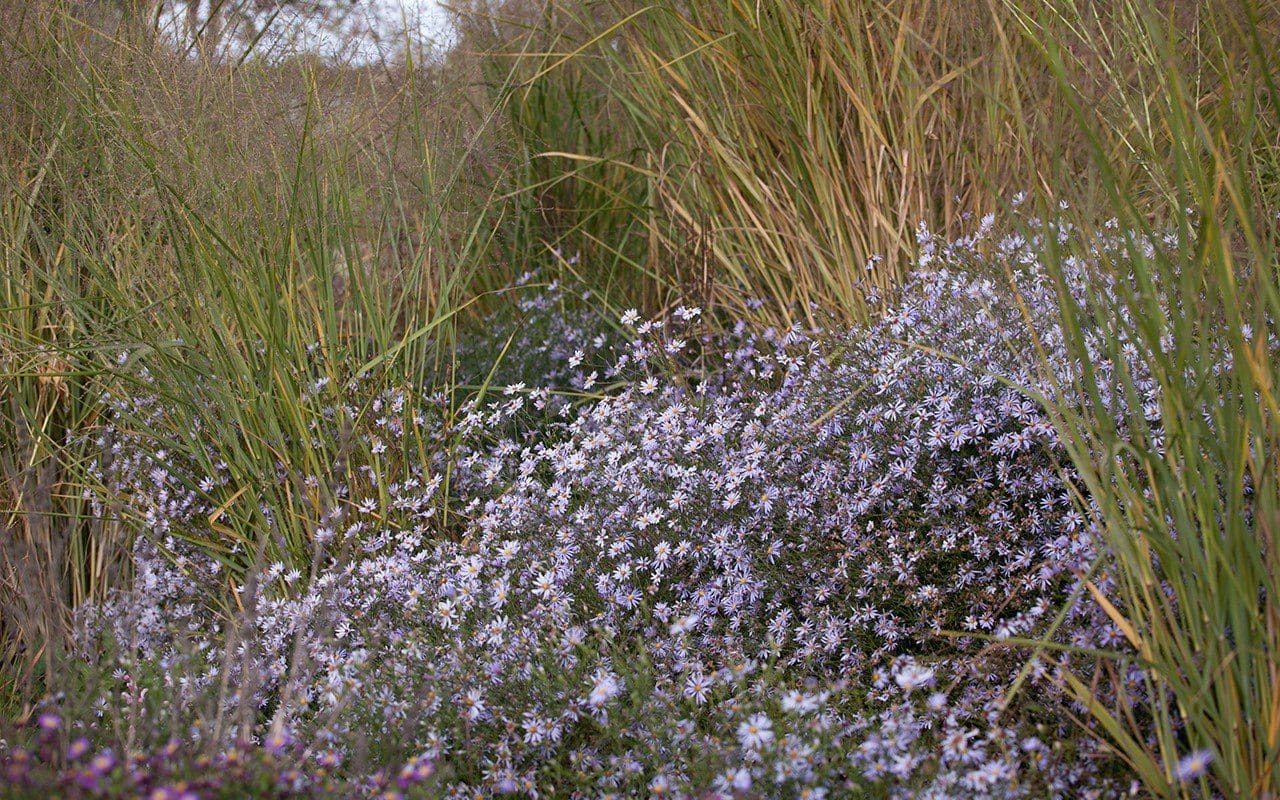 Aster turbinellus growing through Panicum virgatum ‘Cloud Nine’
Aster turbinellus growing through Panicum virgatum ‘Cloud Nine’
 Aster turbinellus
Aster turbinellus
I am not sure yet whether I can say the same for Aster ‘Ezo Murasaki’, which is bulking up steadily. Asters that stay put in a planting are important, but so far I have forgiven this Japanese native its lust for life. It has licorice-dark stems and serrated foliage which you might at first think belonged to a chrysanthemum and that colours with red tints as the temperature falls. It comes into flower in late September at about 60cm, and is at its zenith now. The flowers are single, with bright, violet centres, darkening towards the tips and ageing to royal purple, giving the mass of flower a variance in depth. They also have a bright gold eye which prevents them from feeling sombre. I have them paired with the muted tones of Teucrium hircanicum ‘Paradise Delight’ in an undercurrent beneath Molinia caerulea ssp. arundinacea ‘Transparent’. We will see in time if they creep too readily. Three years of growing them has shown me that they need to be watched, but not worried over like some asters.
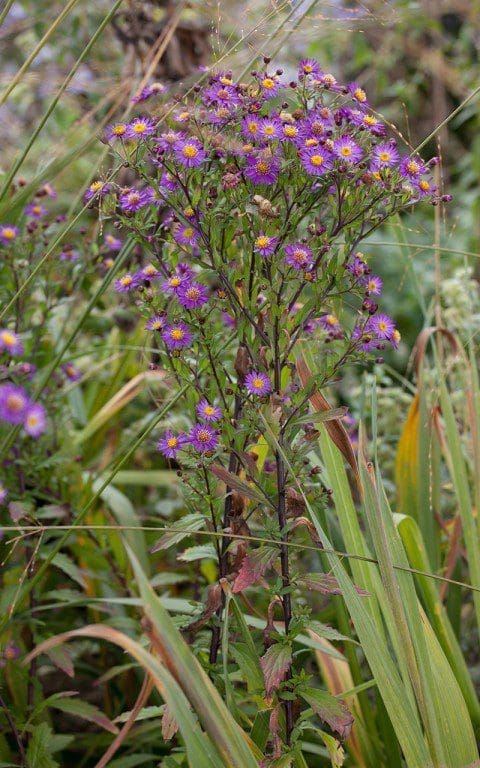
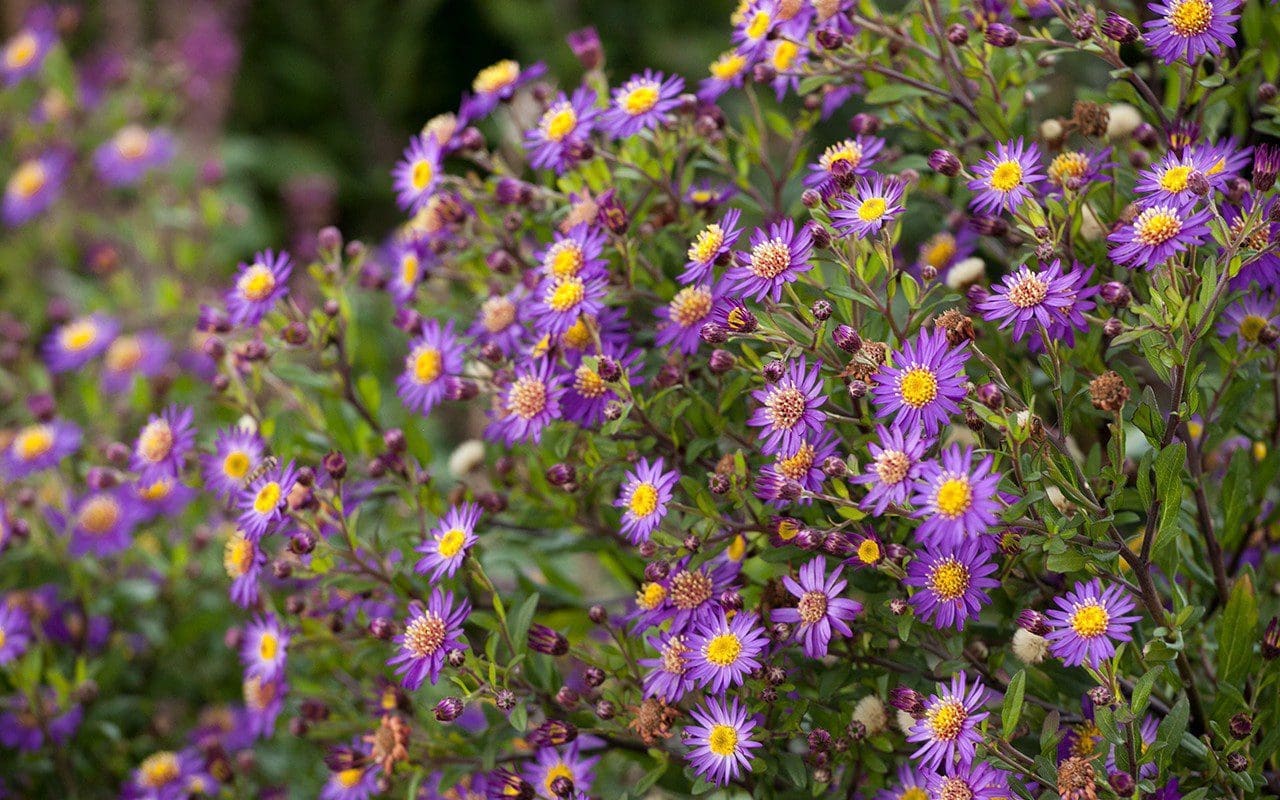 Aster trifoliatus subsp. ageratoides ‘Ezo Murasaki’
Aster trifoliatus subsp. ageratoides ‘Ezo Murasaki’
Close by, and doing better than I had imagined on our open slopes because our soil is retentive, is Tricyrtis formosana ‘Dark Beauty’. I have them grouped under a young crab apple, which will provide them the dappling they need and look better for in time. ‘Dark Beauty’ is a named form that retains the spotting that gives them their common name, the Toad Lily, and I prefer these to the plain selections without spots. However, it isn’t as dark as I had imagined and I’m on the look-out for a deeper-coloured selection having seen and remembered them from my time at The Edinburgh Botanic Garden. If they can be bettered, I will replace them. That said, for the past six weeks they have been a delight and will continue until they are felled by frost.
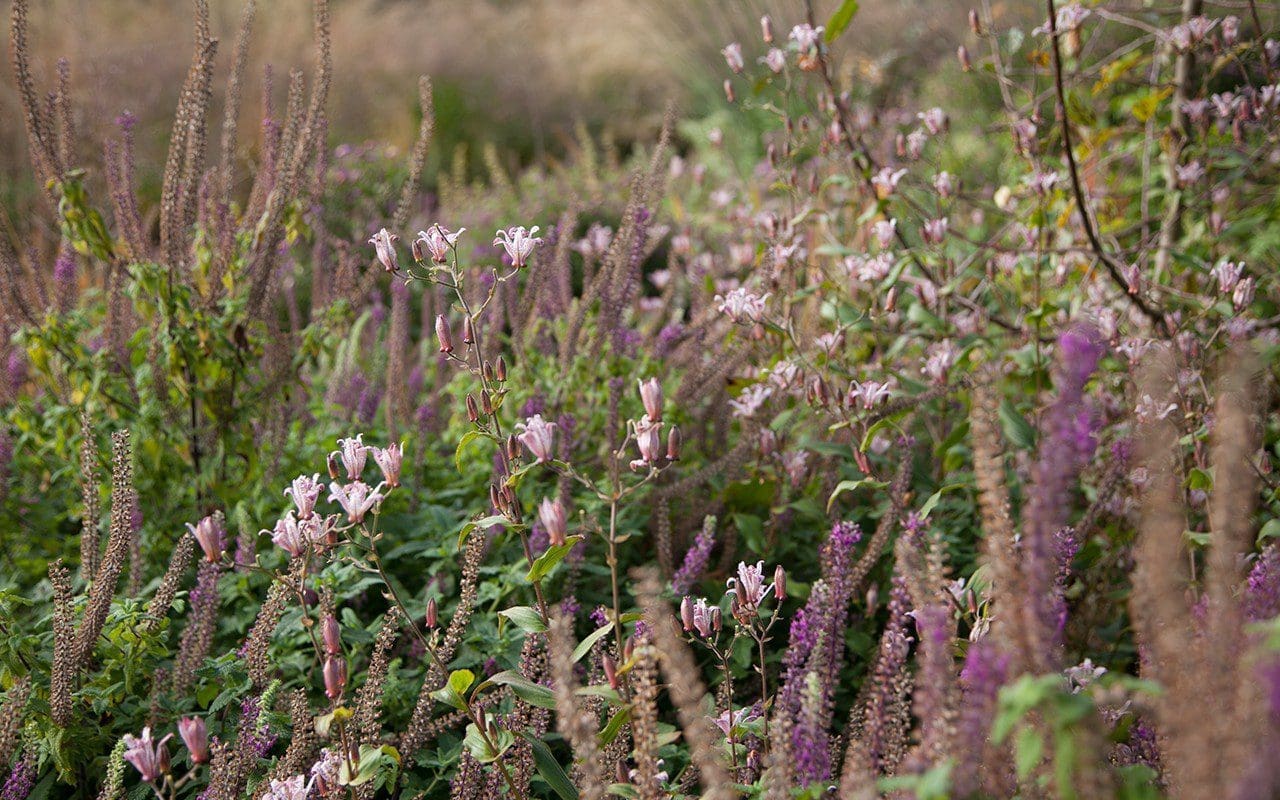 Tricyrtis formosana ‘Dark Beauty’ and Teucrium hircanicum ‘Paradise Delight’
Tricyrtis formosana ‘Dark Beauty’ and Teucrium hircanicum ‘Paradise Delight’
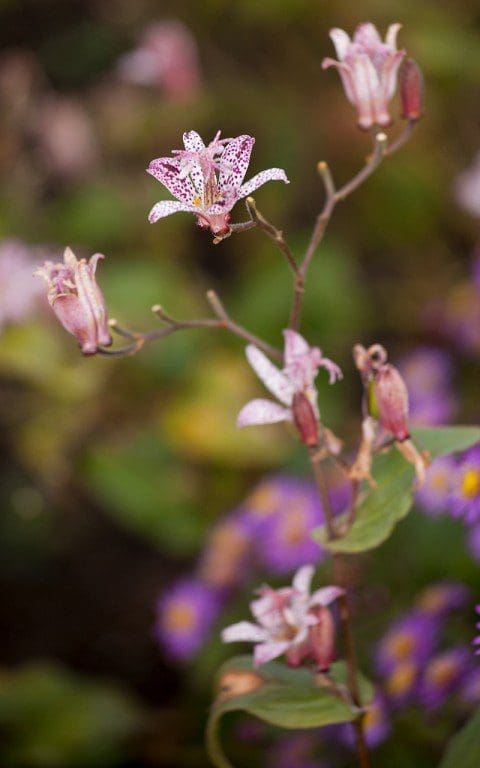 Tricyrtis formosana ‘Dark Beauty’
Tricyrtis formosana ‘Dark Beauty’
Also worth the wait if you can find it a place where the foliage doesn’t burn, are the actaea. A tribe of late-flowering perennials that occur both in Japan and North America, they prefer moisture or retentive soil and cool for their foliage. Where I have used them in the parterre at Lowther Castle, they thrive in the open with the wetter climate of Cumbria, whereas down here in the south, they prefer some shade. Although they are a long-standing favourite, they have often frustrated me in my own gardens over the years. They hated me in Peckham, where my ground was too dry and their leaves burned to a crisp. The dark, ferny foliage earlier in the season is half their appeal and in Actaea ‘Queen of Sheba’ (main image), the greater part of why they are worth the effort. If you can find them a place where they are happy, they never deviate from elegance, rising up tall and taking up no more space than they need in their ascent. ‘Queen of Sheba’ is distinct from the usual vertical line of most actaea, in that its flowers arc in beautifully drawn lines. Dark buds open from the bottom upward to form a wand of light-catching, highly-perfumed plumage that last until the dark nights are with us for sure and the flowers finally fade away.
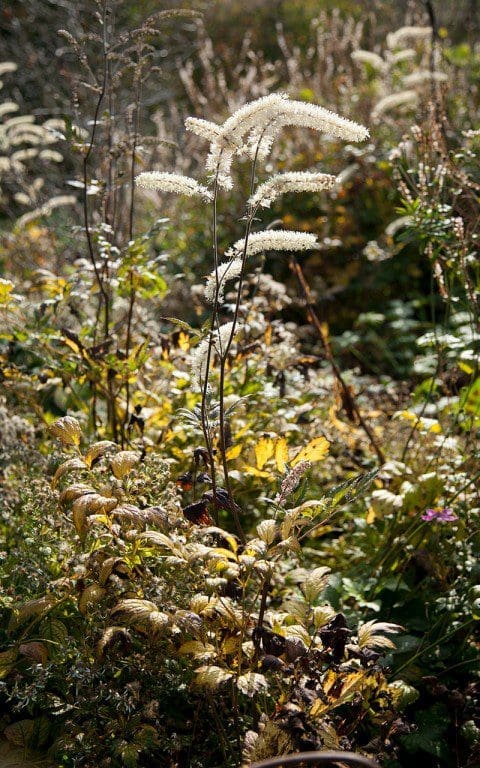 Actaea ‘Queen of Sheba’
Actaea ‘Queen of Sheba’
Words: Dan Pearson / Photographs: Huw Morgan
Published 27 October 2018
Last Monday we awoke to a pristine frost, the first of the year. It lay heavy, sweeping up to tickle the grassy banks, but sparing the giant dahlia in the shelter of the barn. For now. I was up early, the moon still in the sky, to check on the pelargoniums which I’d moved in under cover of the open barn the night before. It was the beginning of the season’s change. From now on the garden will drop back and recede into winter.
In the seven years we have been here this shift has happened almost exactly to the week, but with every year there has been increasingly more to draw from in the garden. Despite the freeze that saw tender nasturtiums wilted and the dahlias in the open blackened, we are far from done in terms of interest. The grasses have come into their own as the colour of flower fades elsewhere. Panicum virgatum ‘Rehbraun’ is of particular note, but it has taken this long to reach its current perfection. The last few weeks have seen this late season grass at its best, the smoky panicles forming a mist amongst the perennials. As the weather has cooled, the foliage has now coloured too, a deep mahogany red.
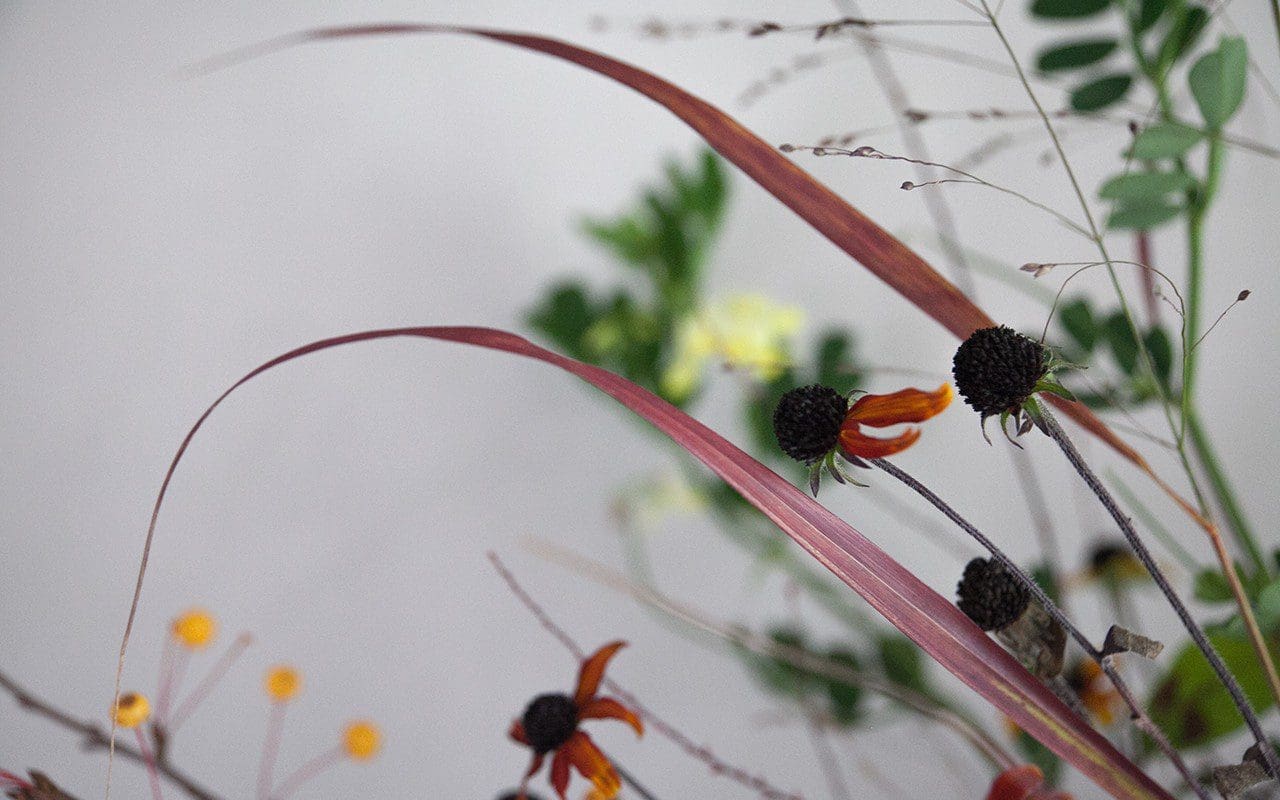 Foliage of Panicum virgatum ‘Rehbraun’
Foliage of Panicum virgatum ‘Rehbraun’
Picked in a bunch the flowers of the panicum act much as they do in the planting to veil their companions and create graphic sweeps with their flamed foliage. Almost anything works in this moody suspension of colour and here we have it with the very last of the Rudbeckia ‘Prairie Glow’. This short-lived perennial is easily raised from seed. Indeed, the plants that I have in the picking beds are variable for exactly this reason. A mix of embers and charcoal, black over red or orange, with some more fiery than others. Desite the strength of colour the impression is light for the flowers are small and held freely with room between each other. In my experience the freer draining the ground in the winter, the more likely you are to keep it. A pinch of seed, taken now and sown early under cover, will ensure that you have it next year.
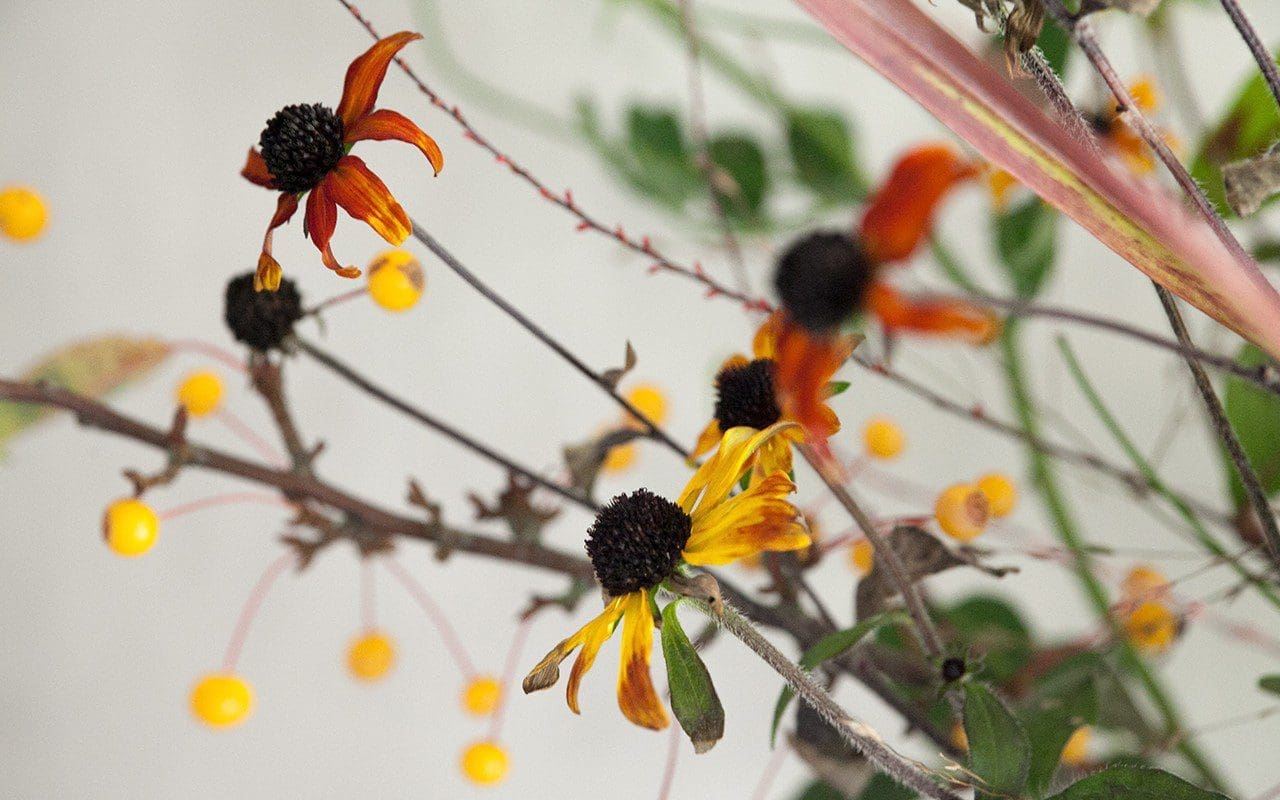 Rudbeckia ‘Prairie Glow’
Rudbeckia ‘Prairie Glow’
The Coronilla valentina subsp. glauca ‘Citrina’ has a second season of flower once the weather starts cooling, its honeyed perfume noticeable quite some distance away. I have it planted by the path so that it is easy to inhale a big lungful. This modest, woody perennial is usually at its best in early spring, flowering prodigiously in March and April and then on into early summer after a warm winter. I put this second push down to youthful exuberance and do not expect the plants to keep this up for more than three years. In the third summer I will take cuttings and replace them in new positions for they are sure to exhaust themselves. Their presence is always light and delightful, the pale yellow pea flowers darker on the lip than the keel. If you can find them a sunny free-draining position, they are easy.
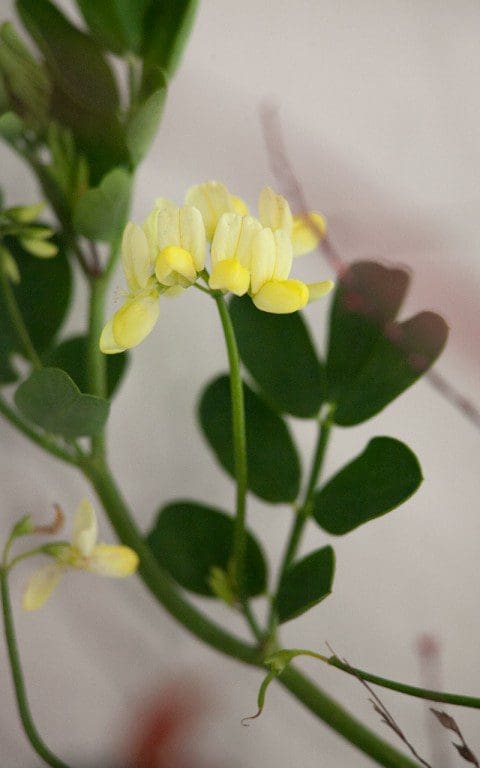 Coronilla valentina subsp. glauca ‘Citrina’
Coronilla valentina subsp. glauca ‘Citrina’
Persicaria virginiana var. filiformis is one of my favourite late season perennials. I grew them first in the Peckham garden, where they seeded freely into the shale I used for the paths. Their presence is light early in the year and, like the panicums, they take some time to come into their own in the latter half of the growing season. Grow them in a little shade or on the cool side of a building for the emerald green in the leaf to set off the maroon chevron of warpaint to best advantage. Out in the sun, the green pales and can look insipid and, as the greater part of the joy in this plant is the foliage, it is worth finding it just the right place. That said, the spires of tiny flowers are worth the wait, forming a pink haze that is hard to pin down at first, but bright and easily detectable once you find the miniature flowers scaling their wiry spires.
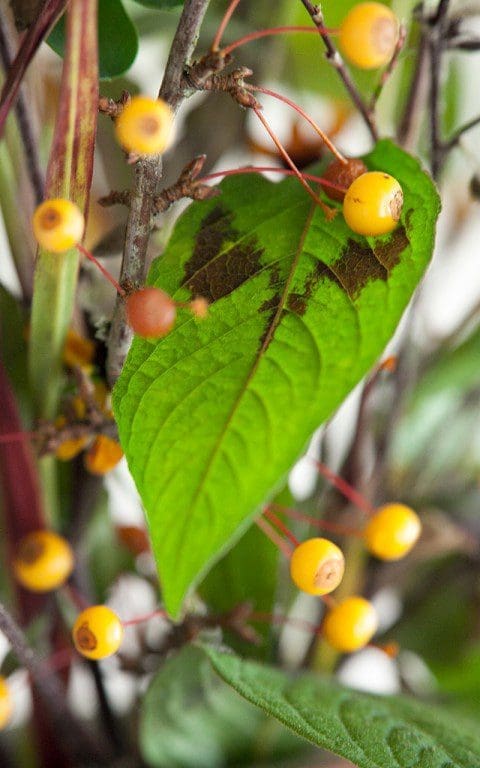 Foliage of Persicaria virginiana var. filiformis
Foliage of Persicaria virginiana var. filiformis
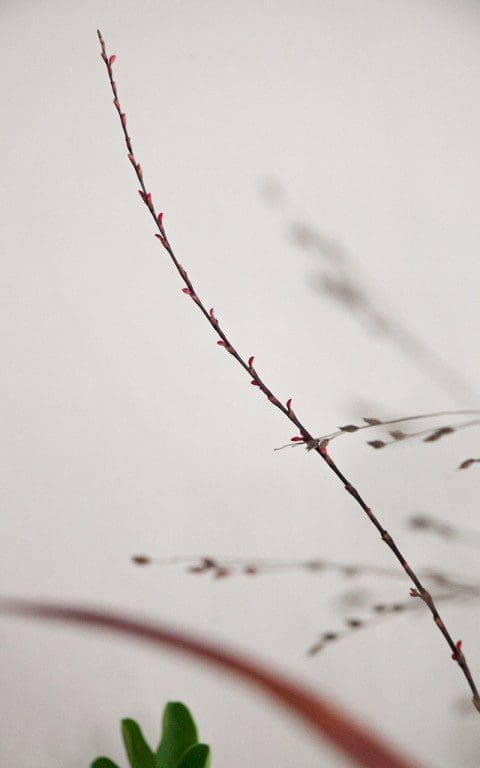 Flower spike of Persicaria virginiana var. filiformis
Flower spike of Persicaria virginiana var. filiformis
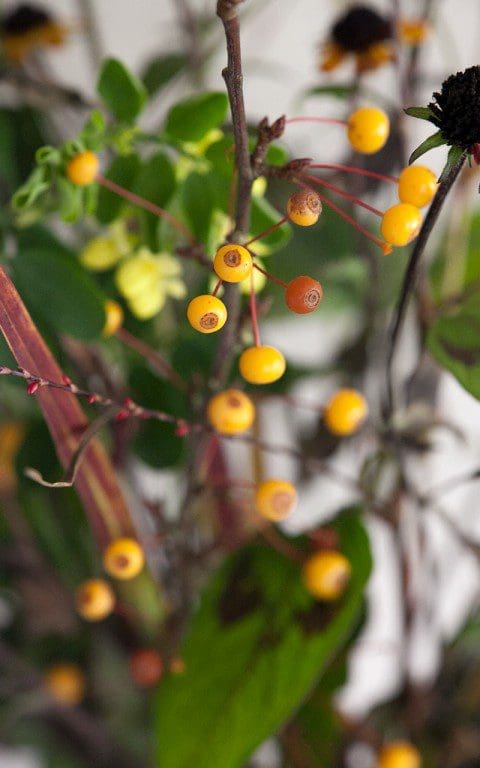 Berries of Malus transitoria
Berries of Malus transitoria
Our Malus transitoria coloured a bright, buttery yellow this year, before the leaves were stripped by gales to leave the berries hanging delicately in their thousands. The tiny amber beads, which darken to a reddish tan as they ripen, are perfectly bite-sized for the birds and every morning they are full of fluttering life. At this teetering point between the seasons this is a moment worth eking out and savouring. A last flash of life before winter gets its grip and competition for the berries will see them vanish with the last of the flowers.
Words: Dan Pearson / Photos: Huw Morgan
Published 11 November 2017
The last week has seen a subtle shift, with a hint of the next season in the air. With cool nights and mist lolling in the hollows, the garden is between two seasons. The brilliant lythrum spires have finally run out of bud and, like sparklers fizzing their length, are suddenly extinguished. The dry days have been spun with the flock from the white rosebay willow herb caught on the breeze. I have planted it on the edges of the garden to blur the boundaries and, after weeks of flower, it is finally running to seed. I know it will need managing as it is a prodigious runner, but thank goodness it is not like our pink native Chamaenerion angustifolium, for the the seed is sterile.
This week’s bunch is a push against this mood, which can all too easily descend as summer runs out of steam and autumn is yet to take over. Over the years I’ve learned to plan for the between seasons lull and now no longer fear it. The Angelica sylvestris is a perfect example of a plant that steps in to fill the gap. In the ditch where we have cleared the damp ground of bramble they are now seeding freely. Although this wetland native has been wonderful since the spring, with it’s coppery foliage and architectural loftiness, the month of August is really its moment. It has been all but invisible for a while, with the grasses staking their position earlier on, but now the pristine umbels are held amongst their spent, tawny seedheads.
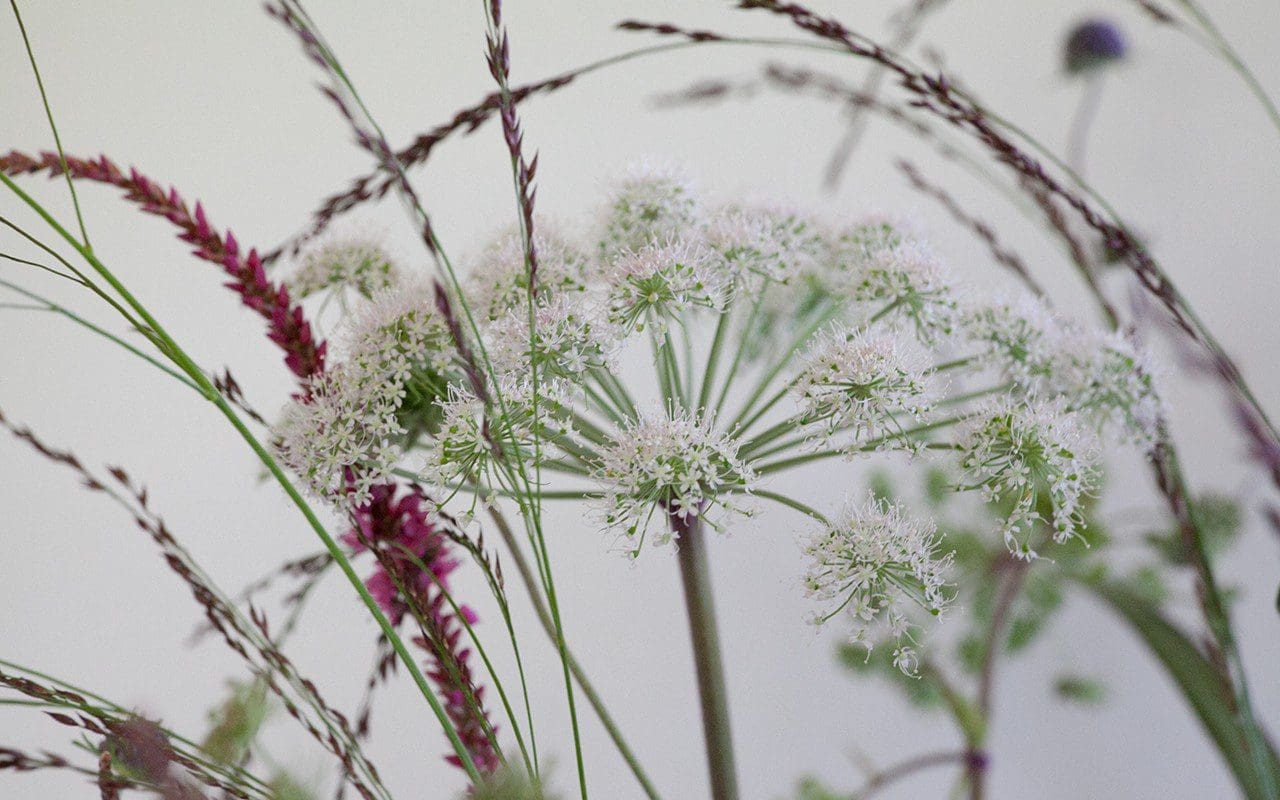 Angelica sylvestris
Angelica sylvestris
Some years, when we walk the ditch early in the season, you can spot a particularly fine form with dark, plum-coloured foliage. The dark stems are always a lovely feature of the Angelica but, coupled with dark leaves, they can not be bettered. Each year I mean to save seed of the best forms, but have never remembered to mark the plants before they are over and browned to skeletons. This autumn I plan to bring a selection called ‘Vicar’s Mead’ into the damper, lower slopes of the new garden. I have grown it without success in London, where it was too dry for it and mildew took its toll, but I trust the ground to be hearty enough here. Though biennial Angelica sylvestris will seed freely and, as long as you leave a number of seedlings, you will always get a succession.
In the garden, I have a particularly lovely form of the perennial Angelica edulis, which is planted through the white Persicaria amplexicaule. The substance and loftiness of the umbels with their horizontal conclusion is a good compliment to the finely drawn verticals, which echo the now spent grasses that surround the angelicas in the ditch. Persicaria is a mainstay of my plantings, which I have depended on for years. Happy with the cool of company at the root and with its head out in the sun, its lush foliage is an excellent team player. Good for the first half of the summer with its overlapping shield-shaped leaves, you know the season is progressing when the first spires arrive at the end of July. Again, August is their month, but they will sail through September and still be firing away in October with the asters. Here, for contrast with the blue, is a new favourite, Persicaria amplexicaule ‘September Spires’, which is tall enough to be making its way through the Verbena macdougalii ‘Lavender Spires’, and is an enlivening shade of hot pink.
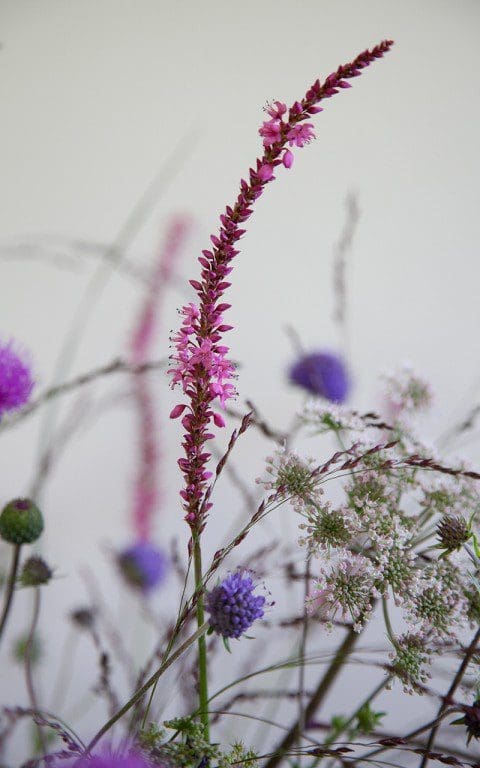 Persicaria amplexicaule ‘September Spires’
Persicaria amplexicaule ‘September Spires’
The Panicum virgatum ‘Rehbraun’ is a late-season grass. Slow to get started in the early summer and needing space early on so as not to be overwhelmed by early-into-leaf companions. An American native known as Switch Grass, it is happiest on lean ground and in bright conditions. Here it is better in soil that is drier or it will lean and topple. I have it on the upper, free-draining slopes where it is already showing colour with reddened tips to the foliage. The plum-coloured flowering panicles are so fine and delicate that you can see through their dusky framework. By the end of the month they will ascend to a final height of about a metre and will then go on to colour brilliantly in October, fiery and lit with their own inner light it seems.
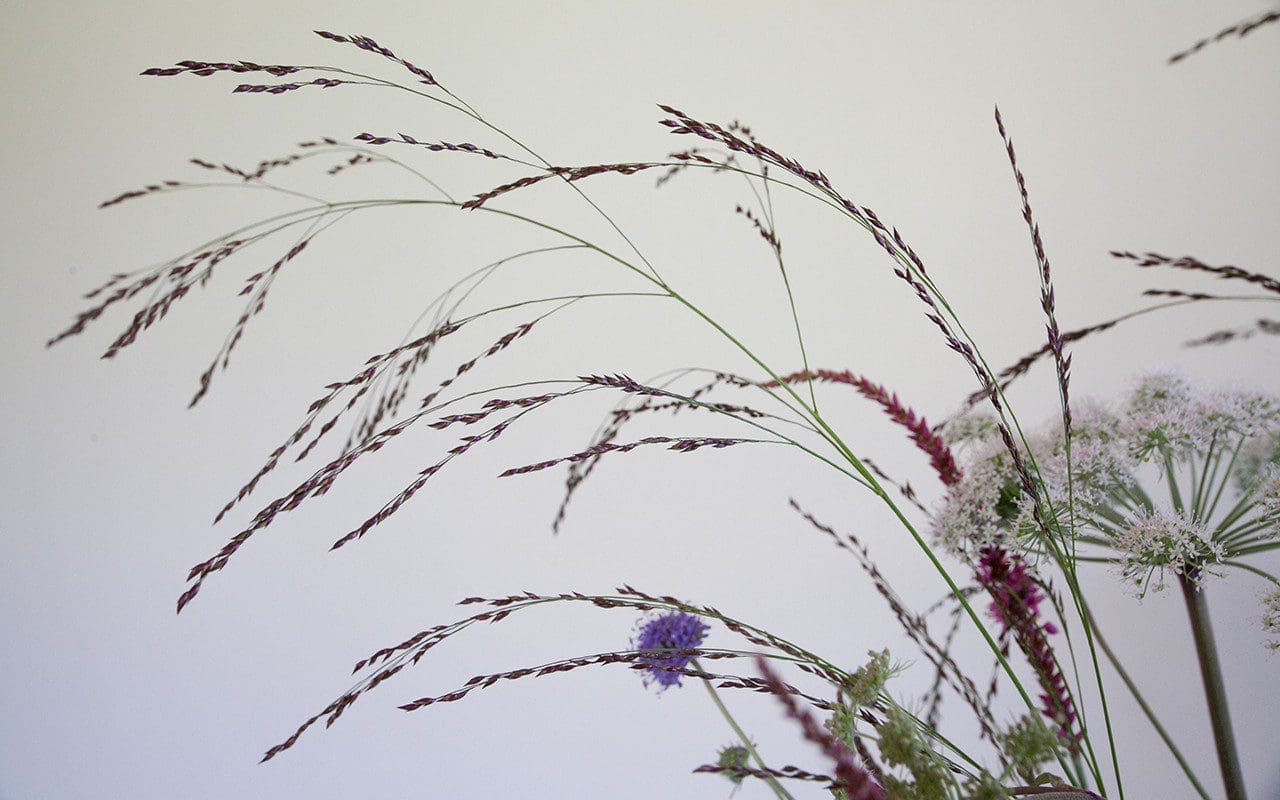 Panicum virgatum ‘Rehbraun’
Panicum virgatum ‘Rehbraun’
I have them planted close, but not too close, to the Cirsium canum, which is as lush as the grass is fine. I bought this perennial thistle from Special Plants where Derry Watkins has it growing in her garden. She swore then that it wasn’t a seeder, as I had been stung by its similar cousin, the native Cirsium tuberosum. The latter has now been banished from the garden to the ditch banks for bad behaviour in the seeding department and, for the past three years, has been kept in check by the competition. When I last saw Derry and asked her if her C. canum had started to seed she said, “a little”, which was due caution, so I will raze my plants when the main show is over to avoid the inevitable. Their stature, reach and poise are beautiful though, the brilliant pink thimbles of flower spotting colour in mid-air just above our heads and humming with bees.
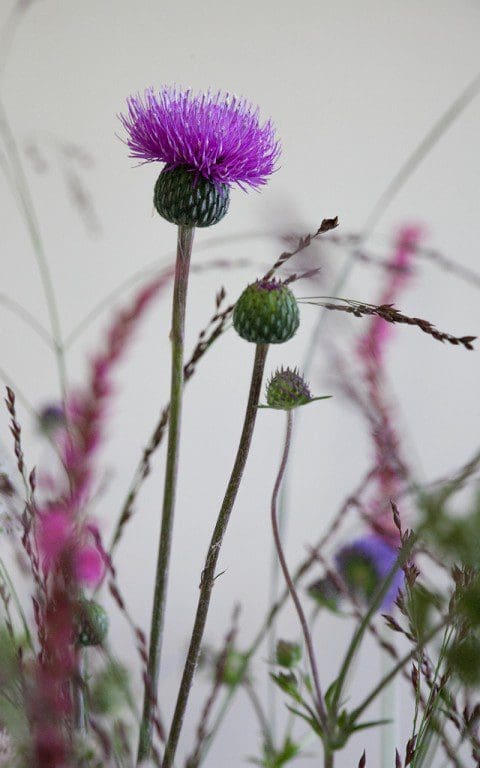 Cirsium canum
Cirsium canum
 Succisa pratensis
Succisa pratensis
Though at an altogether smaller scale, the Devil’s Bit Scabious has a similar feeling in the suspension of flower on wiry stems. Another native, Succisa pratensis is a late-performing meadow dweller, happiest where the soil is moist and picking up where many other natives have gone over in August. My original plant, a dark blue selection called ‘Derby Purple’ was the parent of the seedlings in this bunch. They came easily from seed, germinating the same autumn they were sown and flowering just a year later in the new plantings. Although the flowers are darker than the native, they are not as rich as their parent, but they are a wonderful thing to have hovering around in this between season moment. A neat rosette of foliage, that will slowly increase and clump, is easily combined in well-mannered company. I will keep them away from the Cirsium and run them instead through the openly spaced Switch Grass and be happy in the knowledge that their contribution will help to bridge the season.
Words: Dan Pearson / Photographs: Huw Morgan
Published 19 August 2017
We are sorry but the page you are looking for does not exist. You could return to the homepage